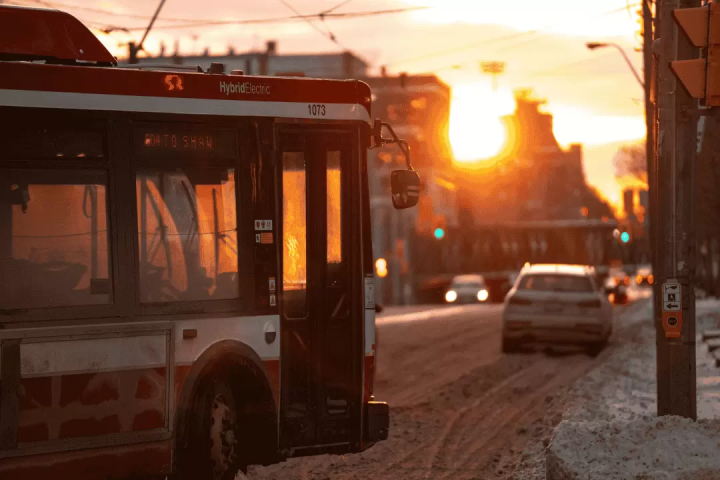Shinjuku Station Expert Guide: How to Make Your Train Transfer

Shinjuku Station is one of the largest and busiest transportation hubs in Japan. With numerous train lines converging here, navigating transfers can be challenging. This guide will help you transfer smoothly from the JR lines to other lines at Shinjuku Station.
Shinjuku Station: Tokyo's Leading Hub Station
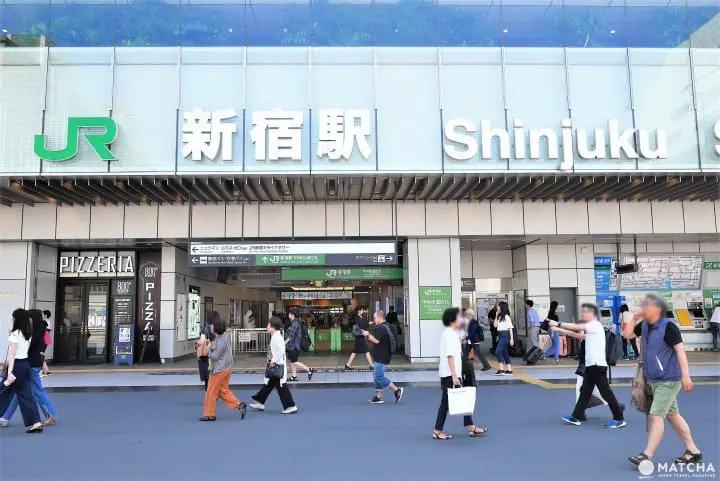
Tokyo's Shinjuku district is dotted with long-standing department stores and gigantic fashion buildings, as well as drinking quarters such as Kabukicho and Golden Gai. People gather in this sightseeing spot at any hour of the day.
The base for access is Shinjuku Station, which is home to the world's largest number of passengers. Because it's one of Tokyo's main spots, several train and subway lines converge here—a vast complex that even confuses Japanese travelers.
Read on to learn how to transfer to private railways and subways at JR Shinjuku Station.
JR Shinjuku Station Guide
7 Train Lines With Access From JR Shinjuku Station
1. Transferring to the Odakyu Line
2. Transferring to the Keio Line
3. Transferring to the Tokyo Metro Marunouchi Line
4. Transferring to the Toei Oedo Line, Shinjuku Line, and Keio Line
5. Transferring to the Seibu Shinjuku Line
Read also
7 Train Lines With Access From JR Shinjuku Station
*Click on the name of the train line and you'll be taken directly to that specific section.
| Name of Line | Transfer Gate | Nearby Sightseeing Spots |
| 1. Odakyu Line | Odakyu Line Transfer Gate (2F) Central West Gate (B1F) |
Hakone, Shimokitazawa, etc. |
| 2. Keio Line | Keio Line Transfer Gate (B1F) *Access from stairs next to B1F Central West Gate (Keio Line) | Mt. Takao, Hachioji, etc. |
| 3.Tokyo Metro Marunouchi Line | West Gate (B1F) | Ginza, Koishikawa Korakuen, etc. |
| 4. Toei Oedo Line | South Gate (2F) | Tsukiji、Roppongi, etc. |
| 5. Toei Shinjuku Line | South Gate (2F) | Jimbocho, etc. |
| 6. Keio Line | South Gate (2F) | Hatsudai Station, Moto-Yawata Station, Sasazuka Station |
| 7. Seibu Shinjuku Line | East Gate (B1F) | Takadanobaba, Honkawagoe, etc. |
Shinjuku Has Several Stations
In addition to JR Shinjuku Station which services the seven above-mentioned lines, there are also the Shinjuku 3-Chome Station and Shinjuku Nishiguchi Station in the area. These stations are conveniently located within a five-minute walking distance from JR Shinjuku Station.
In this article we'll be focusing exclusively on JR Shinjuku Station.
JR Shinjuku Station: Ticket Gates Are Divided Into Above Ground and Underground
JR Shinjuku Station has ticket gates both above ground (2F) and underground (B1F). There are three main gates: the East Gate, West Gate, and South Gate.
▼Shinjuku Station's Main Ticket Gates
・Above Ground (2F): South Gate
・Underground (B1F): East Gate, West Gate
For details on each exit and nearby tourist spots, please see this MATCHA article: Shinjuku Station Exits: A Beginner's Guide to the Area
There are several walking routes you can take to transfer to each line, but this article will introduce the easiest ones.
Read also
1. The Odakyu Line Transfer Gate
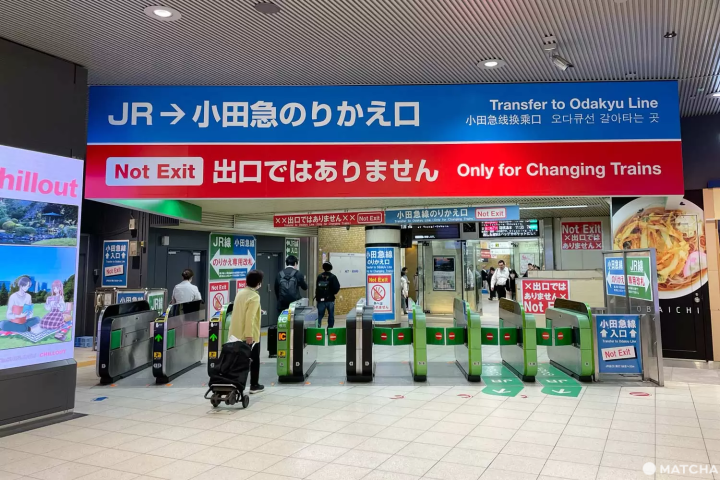
Odakyu Line Transfer Gate (2F)
The Odakyu Line is handy when going to Hakone. If you ride the Odakyu Romance Car you can get to Hakone Onsen, the gateway for Hakone sightseeing. One-way travel time is about one hour and 30 minutes and costs 2,470 yen.
Additionally, even if you don't use the Odakyu Romance Car, you can get to Katase Enoshima Station, the closest station to Enoshima (about one hour and 40 minutes, 650 yen), and Shimokitazawa Station (about 10 minutes, 170 yen) without making a transfer.
We introduce three ways to transfer to the Odakyu Line from a JR line.
1. If You Have Luggage Use the Odakyu Line Transfer Gate (2F)
Near the Odakyu Line Transfer Gate on JR Shinjuku's second floor, there's a convenience store and shops where you can enjoy a light meal. So if you'd like to purchase something before making your transfer, then it's a good idea to use this gate.
We also recommend this gate for travelers with lots of luggage, because there's an escalator going up to the second floor.
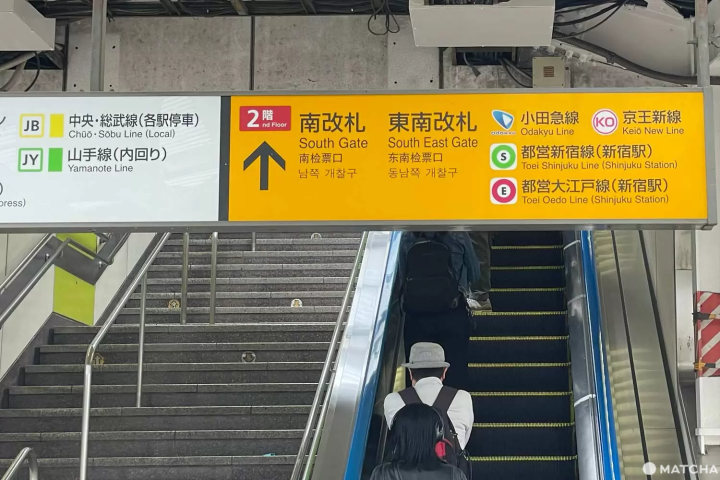
Take this escalator to reach the South Gate on the 2nd floor
Upon arrival at JR Shinjuku Station, look for the escalator going up to the South Gate and proceed to the second floor.
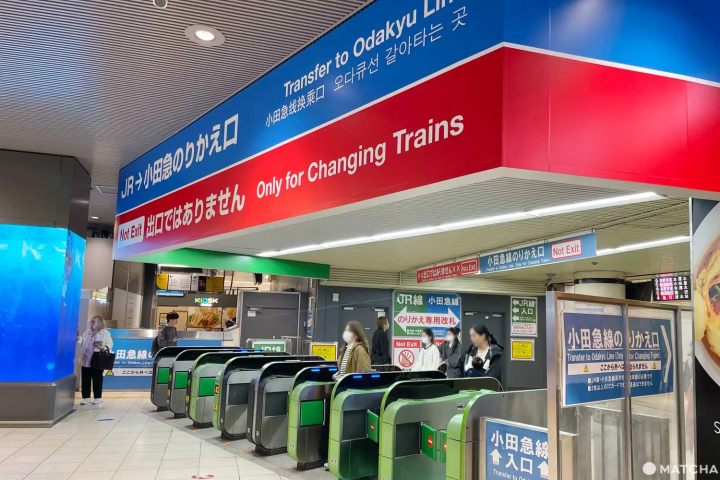
Odakyu Line Transfer Gate (2F)
If you take the escalator up to the second floor, you'll soon see a sign saying, "Transfer to Odakyu Line (photo above)."
If you have an IC card, you can pass through this gate and transfer directly to the Odakyu Line!
2. Use the Central West Gate (B1F) for Smooth Transfers
If you use the JR Central West Gate on the B1F (Basement 1st floor), you can easily transfer to the Odakyu Line which has boarding platforms from the B1F to the first floor.
For passengers who don't need to buy a ticket and want to get on board the Odakyu Line train as soon as possible we recommend this transfer gate!

Stairs going down to the Central West Gate
Upon arrival at JR Shinjuku Station, look for the stairs going down to the Central West Gate and proceed to the B1F.
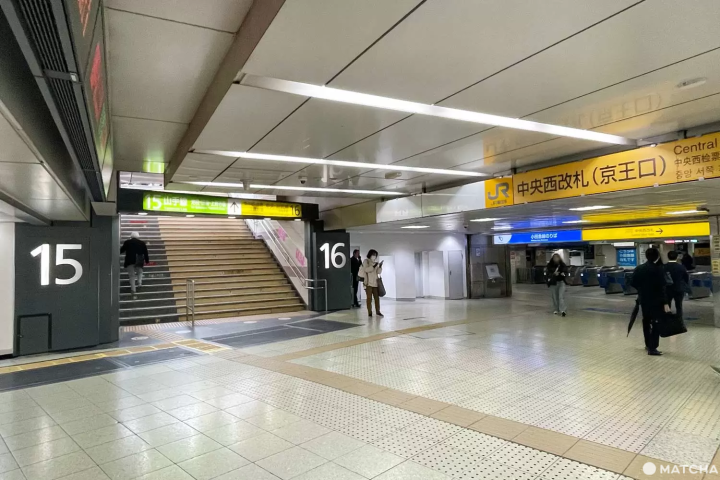
Go in the direction of the blue-colored sign
After going down the stairs, go in the direction of the blue-colored sign (left side in above photo), which indicates the Odakyu Line Transfer Gate.
It's easy if you just remember that the Odakyu Line is blue.
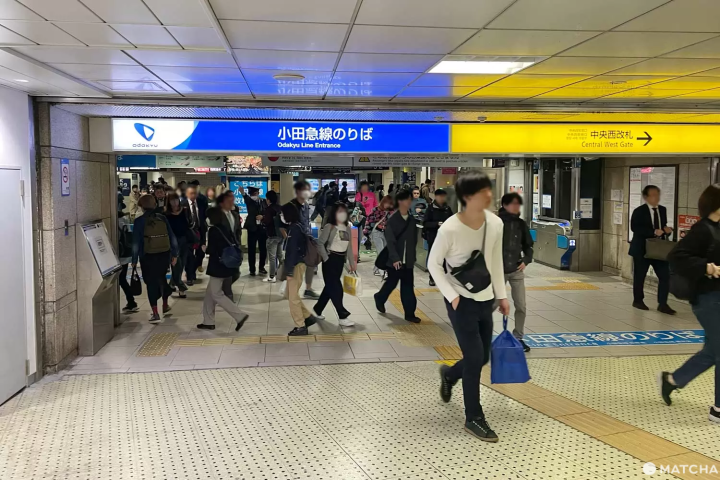
Ticket Gate (B1F) for transferring to the Odakyu Line
This is the Odakyu Line Transfer Gate on the B1F.
3. For Ticket Purchases Go to the South Gate
In the event you don't have an IC card and need to buy a ticket, first of all, pass through the South Gate on the second floor (see photo above).
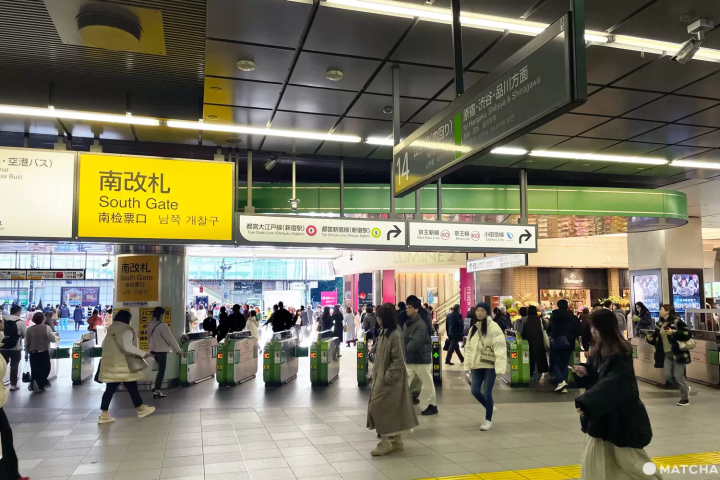
South Gate (2F)
When you pass through the gate and go right, you'll see a sign overhead, "↑Odakyu Line."
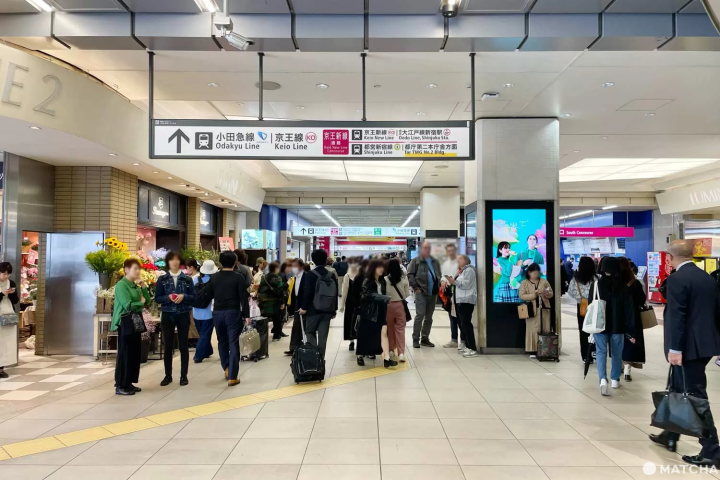
Exit the South Gate and go to the right
Follow the arrow for about 20 to 30 seconds and on the right side facing the direction of travel there will be the Odakyu Line's South Gate (see photo).
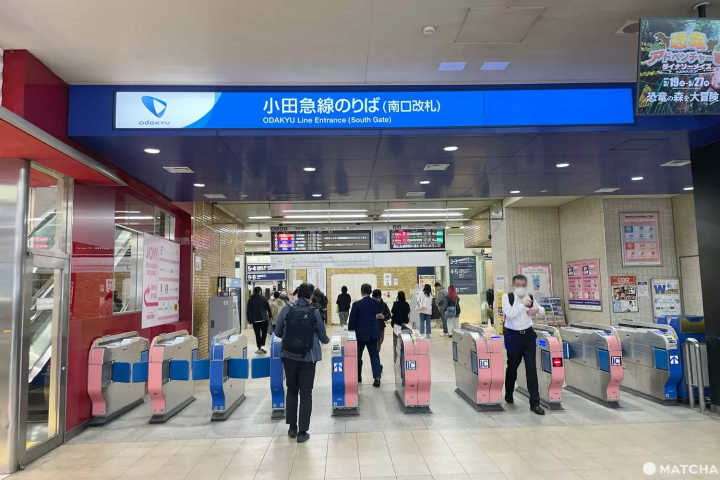
The Odakyu Line's South Ticket Gate
On the right side facing the gate there's a ticket machine. Let's buy our ticket here!
2. Keio Line Transfer Gate
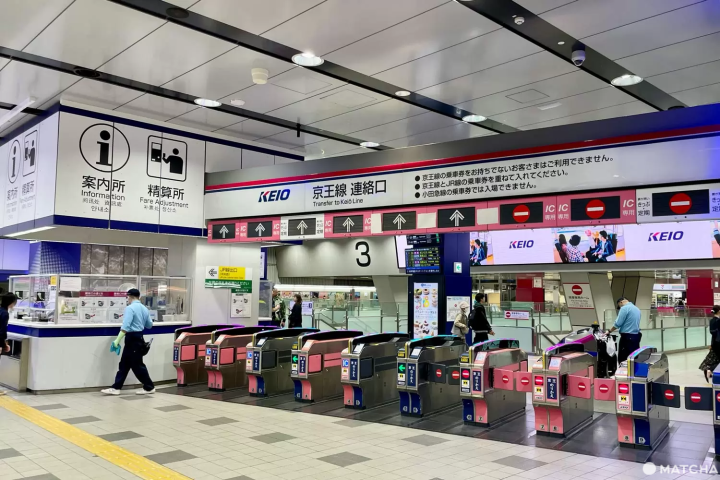
Keio Line Transfer Gate (B1F)
The Keio Line was built as a way of connecting Shinjuku with Hachioji City. So it's very convenient for getting to Mt. Takao and other spots in Western Tokyo. It takes about 50 minutes to get from Shinjuku Station to Takaosanguchi Station and the one-way fare is 430 yen.
For IC Cards and Tickets Go to the Keio Line Transfer Gate (B1F)
If you use the Keio Line Transfer Gate (B1F) you can transfer directly to the Keio Line from JR Shinjuku Station.
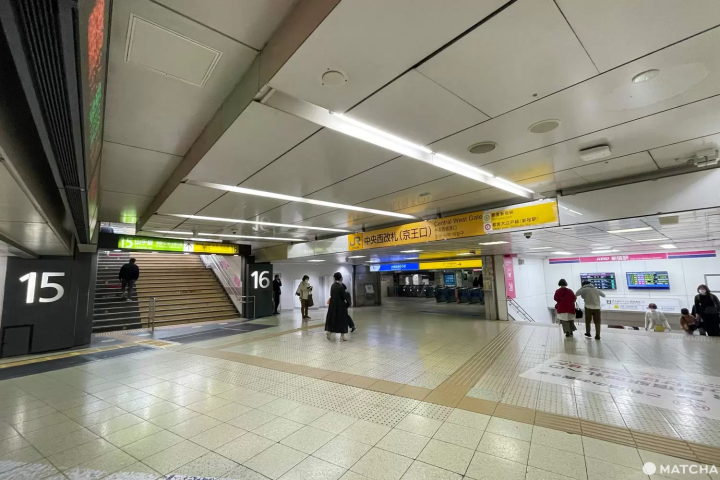
To get to the Keio Line Transfer Gate upon arriving at JR Shinjuku Station, first look for the stairs going down to the Central West Gate and proceed to the B1F.
After going down the stairs to the B1F, do not enter the gate, but instead take the stairs that continue down to the Keio Line and keep going straight.
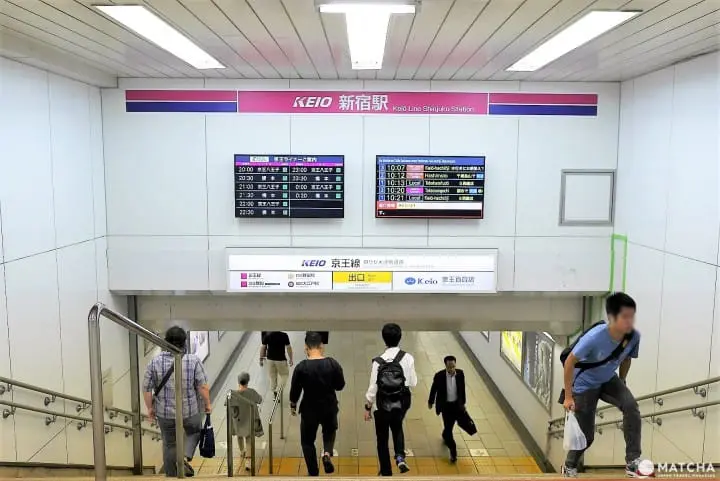
The stairs that continue down to the Keio Line
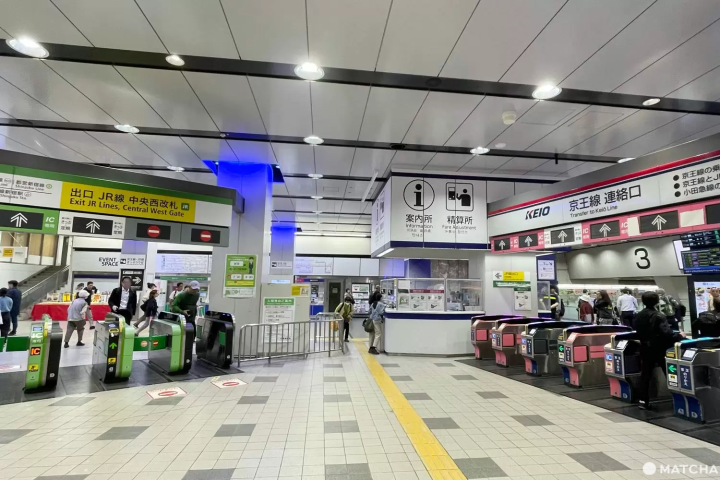
Left: Central West Gate, Right: Keio Line Transfer Gate
Go up the stairs at the end of the passageway. At the top of the stairs on the right will be the pink-colored Keio Line Transfer Gate. From here you'll be able to transfer directly to the Keio Line.
To your left is the JR Line's Central West Gate. Those who need to purchase a Keio Line ticket should pass through this gate. On the other side, there's a ticket machine for Keio Line passengers.
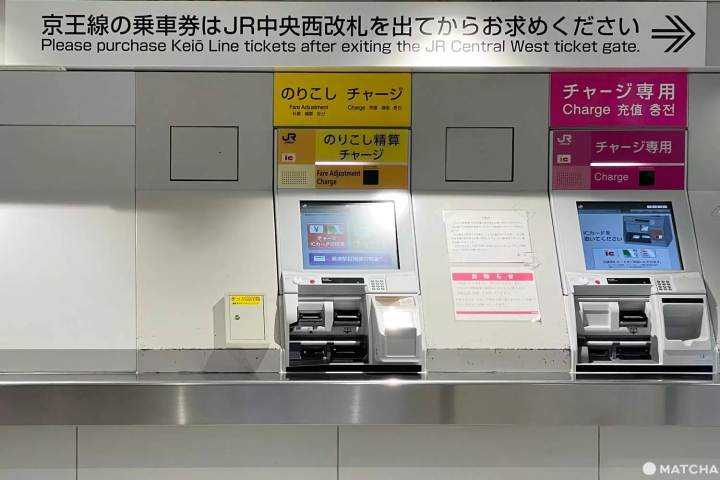
Left: Fare adjustment machine, Right: IC charging machine
For IC card and ticket charging or fare adjustments, use the fare adjustment machine or IC charging machine right in front of the gate.
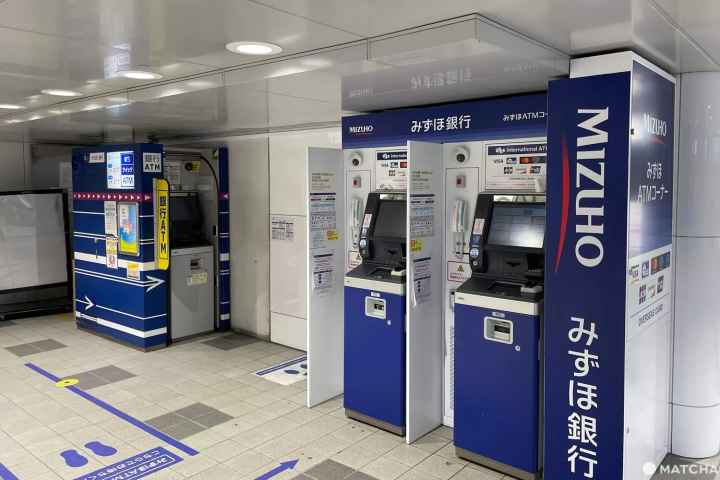
ATM
Right beside the ticket adjustment machine there's also an ATM.
3. Tokyo Metro Marunouchi Line Transfer Gate
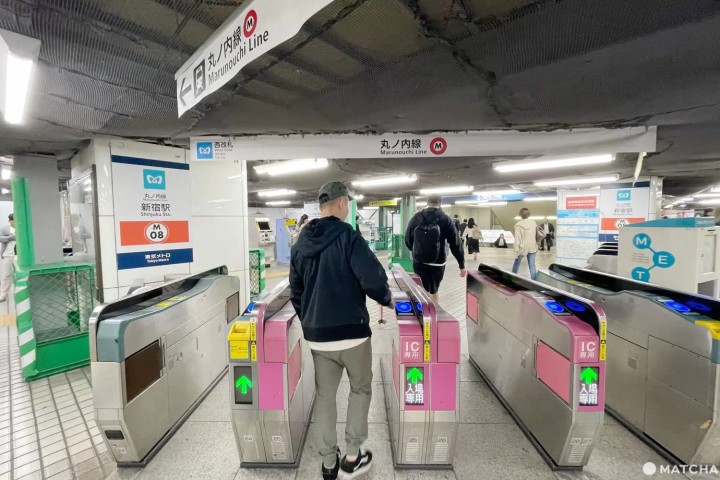
Tokyo Metro Marunouchi Line Gate
Using this gate is convenient when going to Ginza (Ginza Station), the Nihon Teien (Japanese Garden) Koishikawa Korakuen (Korakuen Station), or Tokyo Dome City (Korakuen Station).
The West Gate Is Also Convenient for IC Cards and Tickets!
To transfer to Tokyo Metro's Marunouchi Line we recommend the West Gate due to its close proximity.
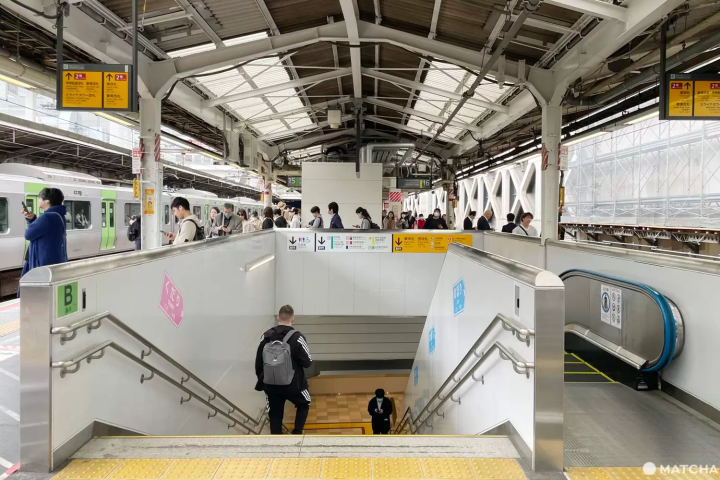
Stairs going down to the West Gate
Upon arrival at JR Shinjuku Station, look for the stairs going down to the West Gate and proceed to the B1F.
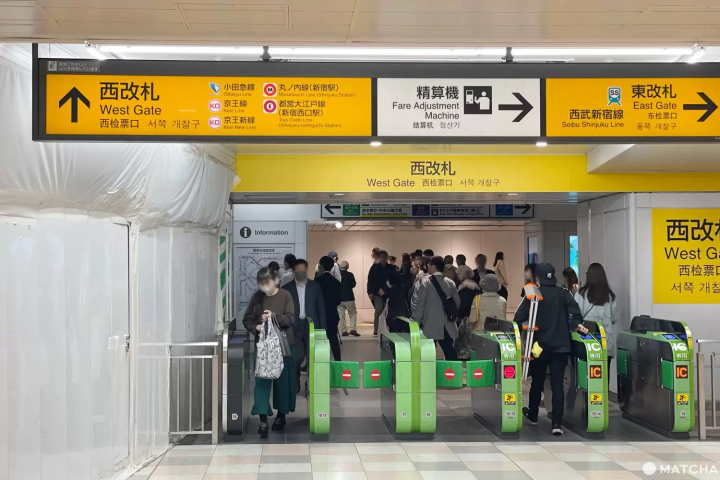
West Gate
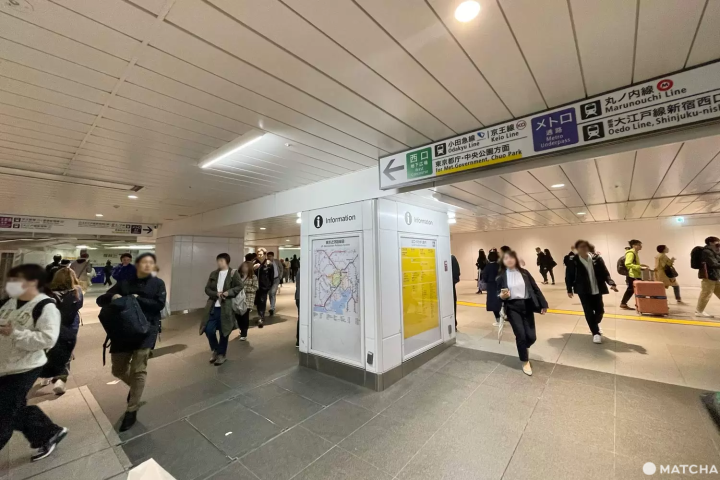
Follow the sign and go left
After passing through the West Gate, follow the sign for the Marunouchi Line and go to your left. After walking for a few seconds, there will be a sign instructing you to turn right and continue on. Follow these directions and go to your right.
It's easy if you just remember that the Marunouchi Line is red!
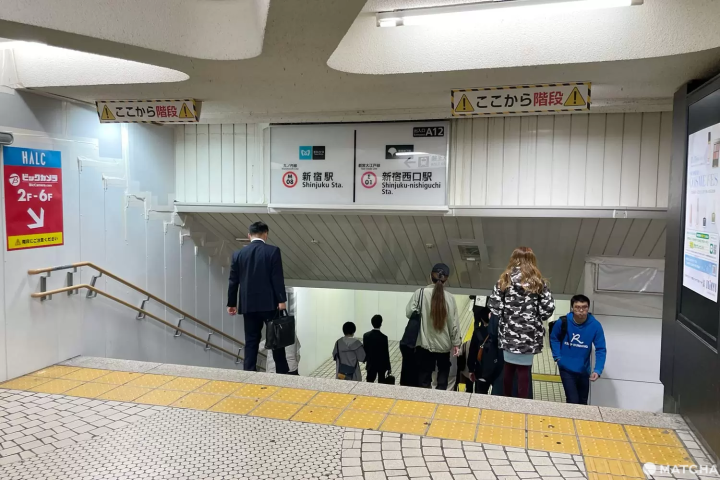
If you go right and keep going straight there will be a set of stairs going down (see photo). When you go down these stairs and continue ahead, the Tokyo Metro Marunouchi Line Ticket Gate will come into view!
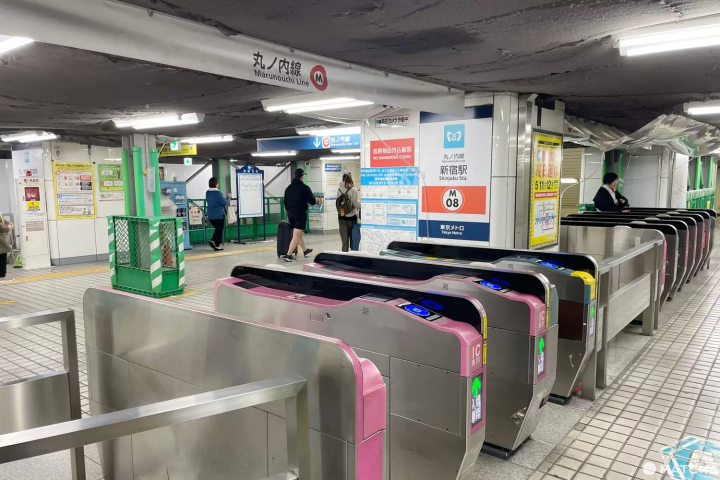
Tokyo Metro Marunouchi Line Gate
For ticket purchases and IC card charging, use the ticket machines right near the Marunouchi Line Gate.
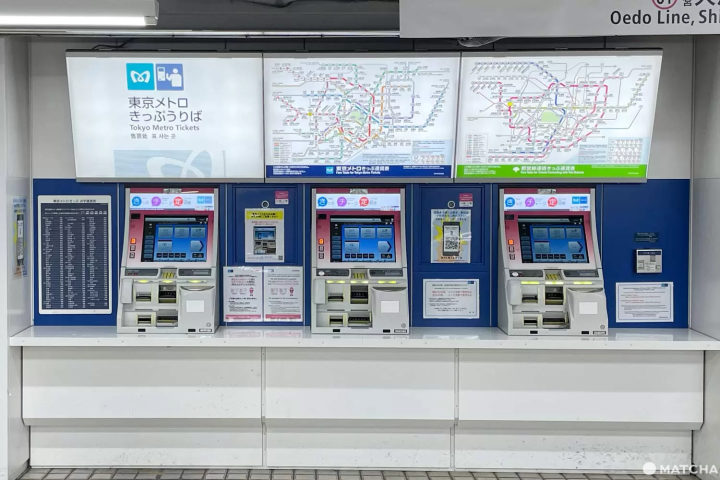
Ticket machines near the Marunouchi Line Gate
4-6. The Toei Oedo Line, Shinjuku Line, and Keio Line Are at the Same Gate!
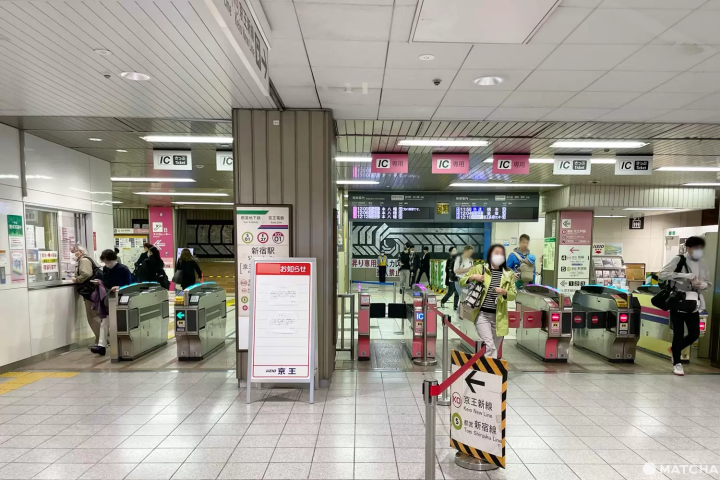
Gate for the Toei Oedo Line, Shinjuku Line, and Keio Line
The Toei Oedo Line, Toei Shinjuku Line, and the Keio Line all use the same ticket gate, so you can remember these three lines together as a set!
Here, the Toei Oedo Line (Roppongi Station), Toei Shinjuku Line (Jimbocho Station), and the Keio Line (Hatsudai Station) all offer convenient access to many stations.
For IC Cards and Tickets Start at the South Gate!
To transfer to the Toei Oedo Line, Toei Shinjuku Line, or Keio Line, first start by passing through the South Gate on JR Shinjuku Station's second floor.

South Gate (2F)
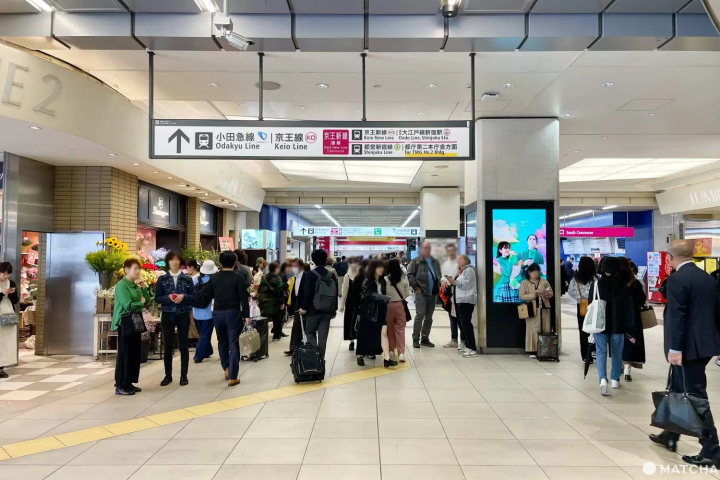
Exit the gates and go to the right
After passing through the South Gate, let's keep going along to the right!
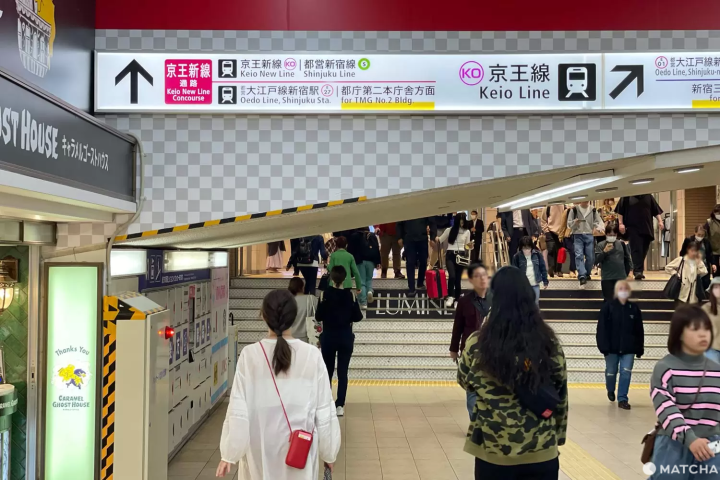
Go up the stairs directly in front of you
Go up the stairs that you can see directly in front (see photo). When you reach the top of the stairs there's an escalator, so take this escalator down.
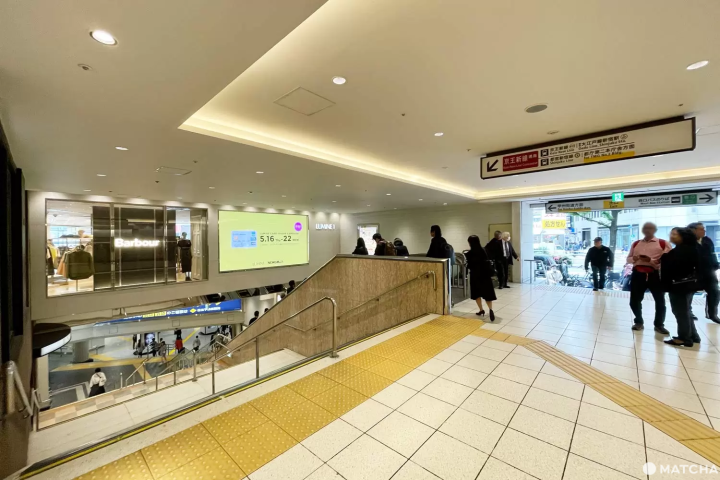
Taking the escalator down
You'll arrive at the spot shown in the photo above. Once again please take the escalator going down.

Gate for the Toei Oedo Line, Shinjuku Line, and Keio Line
When you go down the escalator and the stairs just in front and keep going, you'll see the gates directly ahead. These are the ticket gates for the Toei Oedo Line, Toei Shinjuku Line, and Keio Line.
On your right-hand side, there's also a special ticket gate just for the Oedo Line. If you're taking the Oedo Line you can use either of these two gates!
7. Transferring to the Seibu Shinjuku Line

Seibu Shinjuku Station: Take the Seibu Shinjuku Line here
The Seibu Shinjuku Line is located a slight distance from JR Shinjuku Station. The Seibu Line will take you as far as Waseda University (Takadanobaba Station) and Kawagoe Hikawa Shrine (Hon Kawagoe Station), famous for having the god of matchmaking.
For IC Cards and Tickets Start at the East Gate!
To transfer to the Seibu Shinjuku Line, first head for the East Gate on JR Shinjuku Station's B1F.

East Gate (B1F)
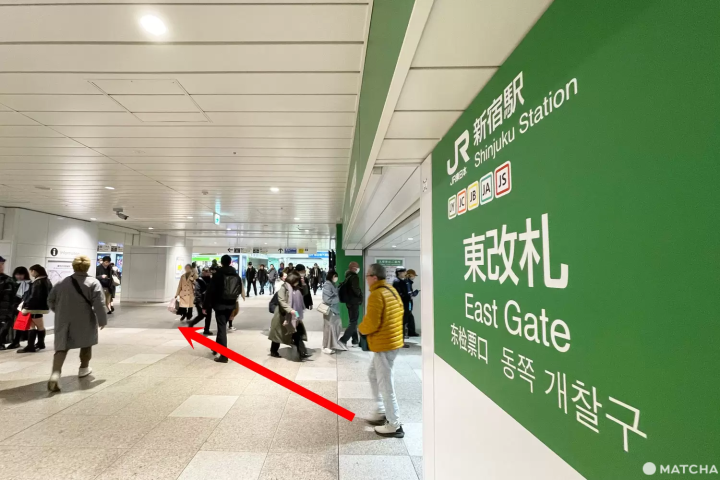
After passing through the East Gate, proceed diagonally to the right.
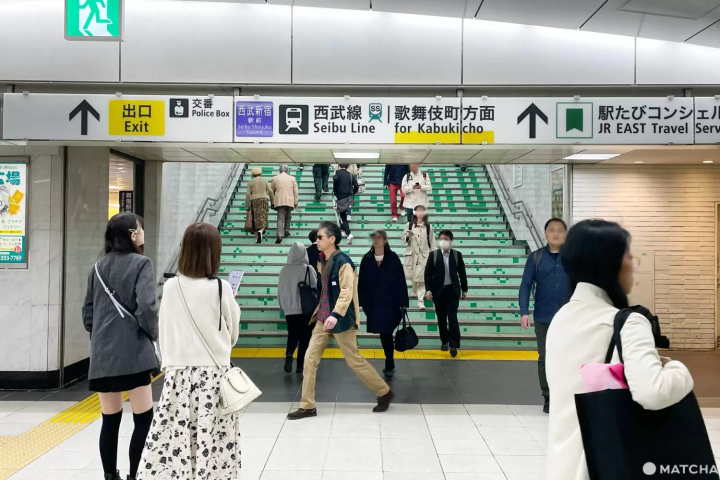
Next, you'll see a set of stairs with a sign indicating the Seibu Line. Take these stairs up (see photo).
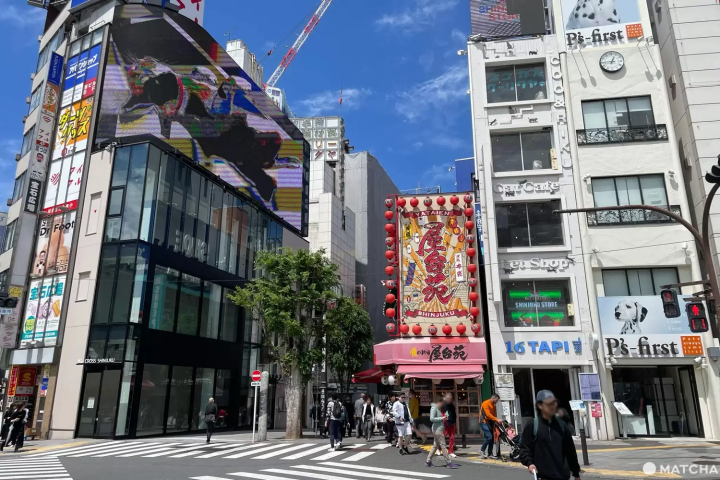
We'll go across the street here
When you surface above ground, continue on and go to your left. Then take the crosswalk in front and go along the street lined with trees shown in the above picture.
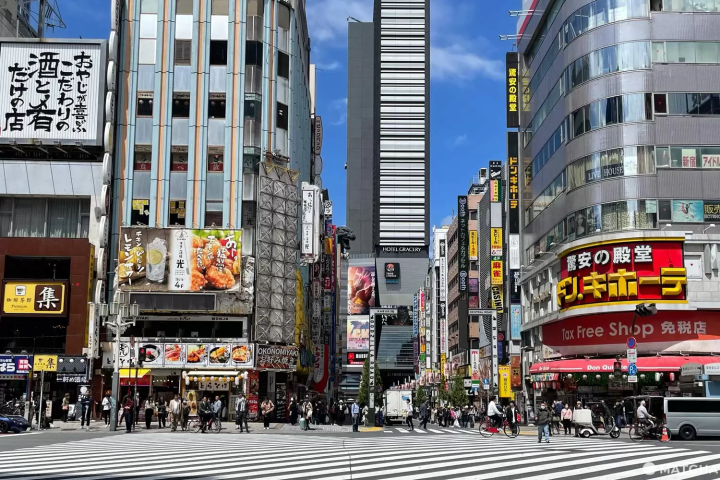
We'll take the crosswalk and head towards Don Quixote
Right in front of you a main street will appear. Go across the crosswalk here, then when you reach Don Quixote, turn left.
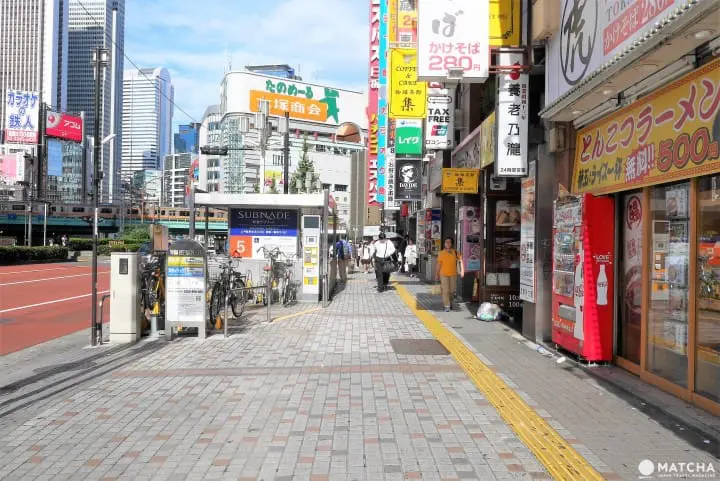
Keep going straight along this street.

Seibu Shinjuku Station: Take the Seibu Shinjuku Line here
If you continue in this direction you'll reach a brown-colored building with a sign that says, "Pe Pe." This is Seibu Shinjuku Station. When you follow the route below the Pe Pe sign all the way to the end, you'll reach the Seibu Shinjuku Line Ticket Gates!
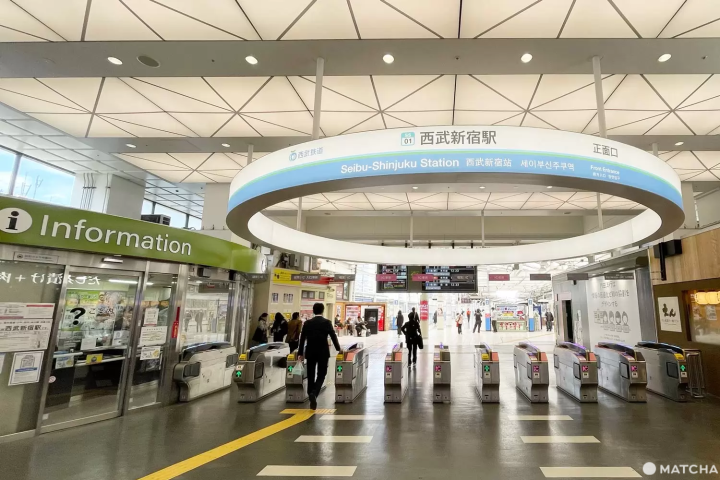
Seibu Shinjuku Station Gate
You can also use this Google Map (Japanese) to help locate the Seibu Shinjuku Line and Seibu Shinjuku Station.
5 Recommended Restaurants Within Walking Distance of Shinjuku Station
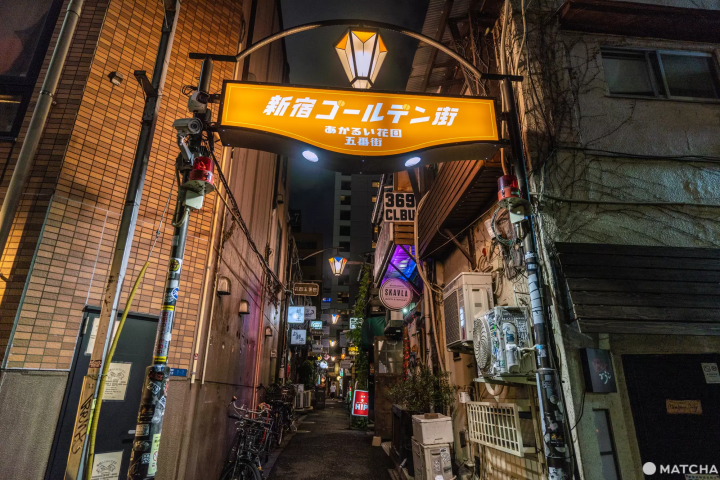
Here, we introduce five restaurants located near Shinjuku Station, all within walking distance, allowing you to enjoy the cityscape as you make your way to them.
Sushi Miyako
Located in one of Tokyo’s most prestigious hotel districts, as well as one of Tokyo’s largest business and shopping areas, Sushi Miyako has been serving both domestic and international guests with exceptional dining experiences for over 40 years. In 2022, the restaurant moved to Hilton Tokyo’s basement level. The menu primarily features two types of Omakase courses which change every month, showcasing seasonal ingredients and the finest Edo-style sushi. For a unique experience, guests can enjoy a variety of exquisite dishes that highlight the flavors of the season. On Sundays and public holidays, the restaurant operates from 12 PM to 7 PM, offering an exclusive lunch course. Counter seating and private rooms available.
Address: Tokyo, Shinjuku, Nishishinjuku, 2-2-1
Access: 12-minute walk from Shinjuku Station West Exit, or 5-minute walk from Tochomae Station
Ando
Enjoy a refined dining experience in a tranquil Japanese-inspired setting with completely private rooms at this restaurant, where you can savor creative dishes and yakitori made from Miyazaki’s premium "Hinata-dori" chicken. The yakitori, carefully grilled over binchotan charcoal, is the highlight of the meal complemented by unique and beautifully presented dishes crafted by a chef with a French culinary background. The interior offers a stylish yet calm ambiance, perfect for various occasions. Whether you're dining alone at the counter, enjoying a meal with friends or a date in a private room, or hosting a group of up to 20 in a spacious private room, this restaurant provides the ideal setting for any occasion. In addition, an English menu and Wi-Fi are available, making your experience both comfortable and convenient.
Address: Tokyo, Shinjuku, Kabukicho, 1-18-9
Access: 3-minute walk from Shinjuku Station
Golden Gai
Golden Gai is a unique, retro district in Shinjuku, known for its narrow alleys filled with about 200 tiny bars and eateries often seating less than 10. Each venue has its own distinct theme and décor, with a history tied to artists and writers. It's a popular spot for both locals and tourists, offering an authentic glimpse of post-war Tokyo. With many bars staying open late, it’s perfect for enjoying Shinjuku’s vibrant nightlife.
Address: Tokyo, Shinjuku, Kabukicho, 1-1
Access: 5-minute walk from Shinjuku Station East Exit
Omoide Yokocho
Omoide Yokocho, often called "Shinjuku's Kitchen," is a nostalgic alleyway with small eateries serving yakitori, ramen, and other traditional dishes. The area’s post-war charm is preserved, with lanterns and neon lights creating a lively atmosphere at night. A perfect spot to experience Japan’s traditional drinking culture, it contrasts beautifully with the modern skyscrapers around it.
Address: Tokyo, Shinjuku, Nishishinjuku, 1-1
Access: 3-minute walk from Shinjuku Station West Exit
JAM17
JAM17 is a dining bar located in Hotel Groove Shinjuku, offering a lively atmosphere with an open kitchen and live cooking experiences. The restaurant features a variety of dishes using fresh, local ingredients, including vegetables from Miura and other seasonal products. In addition to dining, there are other ways to enjoy this venue such as the rooftop terrace with a bar, an art-filled bar area with a historic ambiance, and a gelateria serving high-quality gelato. It is a versatile space for both casual dining and events.
Address: Tokyo, Shinjuku, Kabukicho, 1-17-1
Access: 5-minute walk from Shinjuku Station East Exit.
3 Hotels Just a Short Taxi Ride from Shinjuku Station
Here, we introduce three hotels located close to Shinjuku Station, just a short taxi ride away.
Keio Plaza Hotel Tokyo
Keio Plaza Hotel Tokyo is a luxurious and iconic hotel offering unparalleled convenience and comfort. With over 1,400 rooms, it caters to both business and leisure travelers. The hotel features a wide range of dining options, including 14 restaurants and bars serving both local and international cuisine. Guests can enjoy high-end facilities such as a fitness center, a beautiful outdoor pool, and a relaxing spa. The hotel’s strategic location in the heart of Shinjuku provides easy access to shopping, entertainment, and cultural experiences, making it a perfect base for your Tokyo adventure. Whether you’re here for business or sightseeing, Keio Plaza Hotel promises an unforgettable stay.
Address: Tokyo, Shinjuku, Nishishinjuku, 2-2-1
Access: 12-minute walk from Shinjuku Station West Exit
Hilton Tokyo
Hilton Tokyo offers a blend of elegance, comfort, and convenience. With over 800 guest rooms and a wide selection of amenities, this luxurious hotel is ideal for both short stays and longer visits. The hotel features an array of dining options, including Japanese, Italian, and international cuisines, making it a food lover’s paradise. For those looking to relax, Hilton Tokyo offers a fitness center, a heated indoor pool, and a tranquil spa. Business travelers will appreciate the advanced meeting (もしくは business) facilities, while tourists will enjoy the proximity to Shinjuku’s shopping, entertainment, and cultural spots. The Hilton Tokyo is a perfect base for experiencing the dynamic city of Tokyo with a touch of luxury.
Address: Tokyo, Shinjuku, Nishishinjuku, 6-6-2
Access: 10-minute walk from Shinjuku Station West Exit
Hyatt Regency Tokyo
Situated in the vibrant district of Shinjuku, Hyatt Regency Tokyo offers a seamless blend of modern luxury and traditional Japanese hospitality. This upscale hotel provides a variety of dining options, from Japanese kaiseki to Western-style dishes, and is perfect for those who enjoy fine dining. With spacious rooms, a relaxing spa, and a well-equipped fitness center, the Hyatt Regency ensures guests have everything they need for a comfortable stay. The hotel’s convenient location makes it easy to explore Shinjuku’s famous shopping streets, bustling nightlife, and cultural landmarks. Whether you are here for a business trip or a leisurely vacation, Hyatt Regency Tokyo guarantees an exceptional stay in the heart of one of Tokyo's most dynamic districts.
Address: Tokyo, Shinjuku, Nishishinjuku, 2-7-2
Access: 10-minute walk from Shinjuku Station West Exit
No Worries Even if You Take the Wrong Exit. Just Check the Signs!
As the chart below indicates, you can also use some additional ticket gates when transferring to a particular train or subway line (This article recommended the easiest-to-get-to gates).
Also, there might be times when you pass through a gate and still aren't sure of your bearings! No need to worry. Just double-check the overhead signage.
| Name of Line | Possible Transfer Gates |
| Odakyu Line | West Gate, South Gate |
| Keio Line | West Gate, Central West Gate, South Gate |
| Tokyo Metro Marunouchi Line | East Gate |
| Toei Oedo Line, Shinjuku Line, Keio Line | Central West Gate |
Also, if you check the sign but are still confused, please ask information counter staff or even a station attendant. Please make your transfers smoothly and have an enjoyable trip!
FAQ
Is Shinjuku Line covered by JR Pass?
The Shinjuku Line, which is part of the Tokyo Metro subway system and not operated by JR (Japan Railways), is not covered by the standard Japan Rail Pass. The JR Pass typically covers JR-operated trains, including Shinkansen (bullet trains) and most JR local and express trains, but it does not extend to private railway lines, subways, or buses. Therefore, if you plan to use the Shinjuku Line, you would generally need to pay for that service separately from the JR Pass. It's essential to check the specifics of what is covered by the JR Pass and plan your travel accordingly to make the most of its benefits.
How many entrances does Shinjuku Station have?
Shinjuku Station in Tokyo, Japan, is known for its extensive network of entrances and exits, boasting over 200 of them. This complex station serves millions of passengers daily, making it one of the busiest railway stations in the world. Navigating through its multitude of entrances can be a daunting task for first-time visitors, but each entrance is strategically located to provide convenient access to different parts of the bustling Shinjuku district.
When should I avoid Shinjuku Station?
Avoiding Shinjuku Station during rush hours, which typically occur in the early morning between 8:00 am and 9:00 am and in the evening around 6:00 pm to 8:00 pm, is advisable to steer clear of the heavy crowds and potential delays. Additionally, major Japanese holidays and festival periods, such as Golden Week (late April to early May) and the New Year period (late December to early January), see a significant increase in both local and international travelers, leading to congestion at transport hubs like Shinjuku Station. If possible, planning your visits outside these peak times can help you navigate the station more comfortably and efficiently.
What is the main station in Shinjuku?
Shinjuku Station itself is the primary and central station in the Shinjuku district of Tokyo. It is a massive transportation hub that connects various railway lines, including JR (Japan Railways), private railways, and the Tokyo Metro subway system. With its numerous platforms, entrances, and exits, Shinjuku Station is not only one of the busiest train stations in Japan but also one of the busiest in the world, serving millions of passengers daily. From here, travelers can access a wide range of destinations within Tokyo and beyond, making it a vital transportation hub in the city.
How to know if jr line?
To identify if a train line in Japan is operated by JR (Japan Railways), several visual cues can help. Look for the prominent JR logo displayed on signs, maps, and train cars, serving as a recognizable symbol. JR lines often use specific color schemes for their signage and trains; for instance, the Yamanote Line is distinguished by its green color. Station names typically include "JR [Line Name] Station," indicating JR operation. Ticket gates at JR stations feature the JR logo and designated colors, and ticket vending machines have a distinct design. Route maps, both in stations and online, clearly denote JR lines with the recognizable logo. By noticing these visual indicators and signage patterns, passengers can easily identify if a train line is part of the JR network in Japan.
Why is Shinjuku station so busy?
Shinjuku Station's reputation as one of the busiest train stations globally is shaped by several key factors. Firstly, it serves as a vital transportation hub in Tokyo, connecting various railway lines operated by JR (Japan Railways), private railways, and the Tokyo Metro subway system. Secondly, Shinjuku itself is a bustling commercial and entertainment district, attracting a high volume of commuters, residents, and tourists daily. Its central location and proximity to major business centers and attractions make it a natural convergence point for a large number of people. Additionally, the station's vast size, with numerous entrances, exits, and platforms, contributes to its congestion as travelers navigate its intricate layout. The combination of these factors results in the continuous hustle and bustle that characterizes Shinjuku Station as a hub of activity in Tokyo.
Read also
This is the official account of MATCHA's editorial department. Our articles feature useful travel information for visitors to Japan, from how-to guides to recommended places to visit.


















































